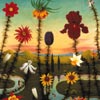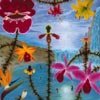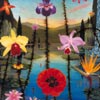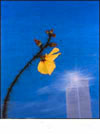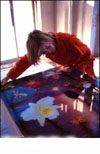THE ART NEWSPAPER , DECEMBER 2001
interview with LC ARMSTRONG
"We were living in a fool`s paradise"
The bomb in the garden
By Adrian Dannatt
Crafting Arcadian images of landscape, sea and floral exuberance, the painter L.C. Armstrong has fused a very American sense of happy innocence with an equally American atmosphere of regret, loss and fear. Armstrong has used commercial bomb fuses for a good decade as a way of creating the charred texture of a distinctly sinister paradise, challenging the luxurious surface of her high-gloss dioramas. Her latest solo show at Postmasters gallery pushes such formalist contradictions even further, presenting her richest and most outrageously colourful flora and fauna in a city of frank dread.
The Art Newspaper: Can you talk about the paintings in your exhibition? L.C. Armstrong: The paintings are pretty easy to describe. Theyıre basically landscapes with flowers in front of them; they are also waterscapes with some land. Every one has water in them. Itıs a take on the classic bathersı scene, but romantic, soaking in it, drinking it. The largest one, "Sea of bliss", looks like pink champagne, the sunset on water. I was thinking of calling the show "Happy hour". Itıs interesting because the first painting I did had two little Twin Towers in it, and I had one foot in doing the whole show with Twin Towers. But then I decided to go with the more classical "bathers" theme and Iım so glad I did because of course the context would have been radically changed and they would not have had at all the same intent.
TAN: Especially as all the paintings use your bomb fuse technique.
LCA: I did a Trade Tower in my last show that had a burst of sunlight on it in a very religious way, with the flower turned away and looking at the tower. That was bought by a man who lives in Oklahoma City. I always intended to do more paintings with the towers, but the ones in this show are only a few inches tall and so almost invisible. The major theme is of bathers half in the water; drinking, intoxication, indulgence and bliss, but also this imminent horror awaiting them in their shadow. Thereıs a strong Paradise Lost sense to them: we were so naïve, living in a foolıs paradise, and we were kicked out on 11 September. These paintings reflect my unease with the way we were being almost giddy, so full of ourselves, and I want to go back to that world! I am not a preacher, Iım the last person to try and stop you having some drink or a good time.
TAN: Were you doing these views of the Twin Towers from your own house, which is very near the site of the disaster?
LCA: I was away for a month in France and there are some small oil studies of sunsets I did there in Normandy. As I had not used oil in a long time Iıd forgotten it takes time to dry. I came back to Tribeca and was really under the gun to finish the show, so was happy to be able to take my daughter for the first day of school and then, of course, all hell broke loose. We were taking her on her way for the first day and the plane hit, and we are very, very close. When the second plane hit we got out so quickI didnıt even take my toothbrush and for two weeks we were like refugees with no home or studio. I got my little oils and travel box and finished the small oil studies down in New Jersey. Then I went back to my studio and put the bomb fuse on them. But the work has always embodied something pretty beautiful alongside something really horrific and I think thatıs the way life is. Itıs never all happy or all sad and you can find beauty in the worst situations and after 11 September we found beauty in the way people were helping each other, treating each other.
TAN: Are these paintings specifically American Pastoral? Do they allude to American landscape painting?
LCA: They definitely do. I always referered to other artists even when I was much more minimal but my historical references now go back a lot further. They certainly refer to the American Hudson River School paintings, though our sense of nature has changed. They would idealise nature and take out any incursion of modernity such as a railway line. Iıve sort of updated that with the bomb fuse.
TAN: You live right by the Hudson River yourself, but itıs rather different to how it appears in their paintings.
LCA: Yes, Iıve always lived near water; I look at the water a lot. I stopped every day and took photos of the Twin Towers by the water. Many of these skies and sunsets were taken at a very classic painterıs place, Villerville, near Deauville in Normandy. A lot of French painters worked there, including Courbet and all the Impressionists. It had a commanding view of the ocean and spectacular sunsets almost every night (also the hour when we drank a lot of wine which made them all the more beautiful). But to get back to your point, one thing Iıve always been sure of is, Iım American. I havenıt always liked that, but my family has been in this country forever.
TAN: Let us not forget you are from West Tennessee; you do not get more American than that.
LCA:No, Iım a little bit Cherokee Indian, a little Scotch Irish, a little French Huguenotthe original mix down there. Theyıve been there since the 1700s and the Cherokee much earlier obviously. Iıve been American for generations. But I had absolutely NO interest in the American painting school; I only came to it through pop culture. The more Iıve studied it now Iıve realised itıs had such a profound influence, this American idea of the transcendence and spirituality of natureon movies, pop culture, album covers. I used to airbrush vans and people would ask for all this romantic imagery; they were asking for a Caspar David Friedrich painting on the side of their van: or more specifically, maybe, they wanted Kensett or one of the American Luminists; they loved those misty moonscapes and sunsets.
TAN: So you were professionally airbrushing vans and trucks
LCA:I was customising vans and motorcycles in the early 70s to put myself through art school. I did race cars, speedboats, airplanes, Hot Rod cars
TAN:How would that very smooth texture compare to your current super-smooth paintings?
LCA:Yeah, itıs the California Fetish Finish, the CFF. Itıs still there. You donıt get paid to make any brushstrokes. Believe me, if you have a brushstroke on that car you donıt get paid. So you learn how to paint very slickly, very smoothly on a hard surface. I still work on a hard surface but now Iım putting linen over the wood, itıs a little more textured, a little more "painterly" sneaking in with the oils. But they still have that glassy car finish.
TAN:And what do you use for your very glossy, very hard finish?
LCA: Itıs resin. It has the viscosity of honey and it has a high surface tension so it levels beautifully; it equals about 40 coats of lacquer. I pour it on. Itıs the opposite of these mass produced paintings which are a photograph onto which they put a texture of brushstrokes.
TAN: Can you explain your use of bomb fuses in the paintings, which one might fear is a gimmick?
LCA:Well I certainly could be accused of using a gimmick! I think everybody needs a gimmick and itıs not so bad. I think itıs a more interesting way to make a line than painting a line and it has a totally different meaning. It ties into process art and even performance art. It makes such a glaring contradiction to the flowers, I think it enhances their beauty. Itıs like a rose with thorns. The bomb fuse is usually the stem of the flowers, but I was using this bomb fuse in my work long before the flowers. I was alluding to colour field painters, stripe painters.
TAN: So where do you get these bomb fuses?
LCA: Well, I donıt think I can get them any more. The FBI came round and said they could not sell them any longer. I bought a whole lot, so Iım set for a while. I lay it down on the painting thatıs already made, light it, and it kinda sizzles. Itıs like the opening of "Mission Impossible" where you see a fuse going across the screen.
TAN:How can you control what sort of line the bomb fuse makes?
LCA: You canıt entirely, I used to do it on the roof and the wind had a lot to do with it. Itıs fire, itıs not something you can tell what to do.
TAN: Surely the paintings also refer to ecology and our idea of nature.
LCA:You know I used to be a dirt bike racer and I tried to destroy the last habitat of the condor. I really didnıt care. I was brought up with the attitude that nature is something to be used, run over. That changed as I grew older and had a child. I love nature now and feel we defile it. I probably defile it more by using resin and bomb fuse! I used to spend a lot of time in California out in the desert and loved it, even as I was racing through it and wrecking it, doubtless destroying carpets of wild flowers.
TAN:Your paintings become more technically proficient and skilful with every show. Is this the result of being a teenage hot rod airbrush artist?
LCA: Iım a highly trained painter. I denied my skills for years, maybe because I thought they were too commercial. I think Iıve found a way to use them that is conceptually strong, that has a historical lineage and is all the richer because of that. Iım like an old-world craftsman. I started working when I was 14 years old. Iım fully trained in classical drawing, in perspective, in colour theory. Iım trained both from art school and also from using my hand, a highly trained, facile hand from when I was 14 years old.
